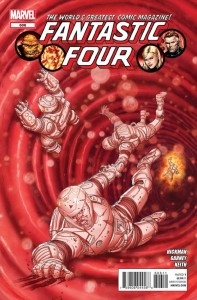 Editor’s Note: Come along and ride on a Fantastic Spoilage!
Editor’s Note: Come along and ride on a Fantastic Spoilage!
First off, let’s stipulate that Fantastic Four editor Tom Brevoort was having a bad day when he recommended that an issue about alternate Nazi versions of the Fantastic Four be labeled as a Point One entry issue, rather than this simple, classic-feeling one-and-done about the core team performing the type of weird, over the top science adventure that is the team’s stock in trade. Yes, a bad day, and not simply colossally poor judgment, or perhaps rampant alcohol abuse. But more likely an off day. Sure.
Let us also stipulate that, while this is an entertaining and charming issue that services all four core characters extremely well and captures the feeling of a classic FF adventure, part of the reason it feels classic is because the plot has been done before. And done, and done, and done, both in movies and in other comics. The thing works, but it works because it’s hung on a proven framework… the same way The Magnificent Seven is cool, but mostly because it’s taken straight across from The Seven Samurai.
The story here is simple: the team is on a mission in an extremely hostile environment to retrieve something that the indigenous life forms will do anything to keep invaders from reaching. The concept is ingenious, because it allows each member of the team to use their powers to not only move through the environment, but to protect themselves from the local lifeforms, which attack them without showing guilt or fear or pain.
Where is this environment? Is it a strange planet, or an area of the Negative Zone, or Brockton, Massachusetts? No, it’s (dun dun DUUUNNNN!) the body of family friend Willie Lumpkin! And the FF have entered his body (wait, what?)… to retrieve a (dun dun DUUUU *cough cough* excuse me) malignant brain tumor!
It’s a cool idea… just like it was in Fantastic Voyage. And InnerSpace. And in Comics 101‘s Scott Tipton’s and my personally fondly remembered comic from childhood: World’s Finest Comics #236. The concept of “astronauts” being overwhelmed by the simple internal processes of the human body, including the immune system, nervous electrical discharge, and the use of fire in a highly-oxygenated environment, is compelling, but it has been done almost to Goddamned death. And while writer Jonathan Hickman does yeoman’s duty trying to hide the fact that the adventure is taking place in a human body until late in the issue, artist Ron Garney’s well-drawn red tunnels, red corpuscles, nerve activity and white blood cells pretty much give the plot twist away early on.
But despite being utterly derivative, where this story works is in the characters. Every member of the team gets a chance to shine here, from Johnny Storm’s previously-mentioned impetuous and ill-advised use of his flame powers with a simple, “Back away, Ben — I’ll clear them out,” to The Thing’s grim (get it?) good humor at having something to hit, to Reed, in response to the question as to how they will handle a tumor that they can’t destroy or disassemble the tumor, answering in close-up: “Steal it.” The only thing this issue is missing is a rousing, “It’s clobbering time!” and frankly, Thing’s simple, “I got this,” in the face of giant attacking monster cells, is more satisfying.
When it’s all said and done, this story has some heart. The way that the team is presented as being deadly serious in intent in their mission, as if they were stopping Galactus, makes the reveal that they are trying to cure a family friend, gives the whole story an emotional impact that, frankly, surprised me. I’ve accused Hickman’s writing of being emotionless and bloodless in the past, but that’s not the case here. It’s a derivative story, sure, but seeing the team’s reaction to hearing their friend’s diagnosis and reacting with the resolve they did was affecting in a way I wasn’t expecting… and it made me resolve that, if I ever become friends with the Fantastic Four, I’m going right back to two packs a day with a clean and bright conscience.
Garney’s art in the issue is effective… and as I said previously, perhaps too effective, as it gives up the game earlier than I think Hickman would have preferred. His style is reminiscent of standard 90s stuff, with a lot of detail lines, but the lines are thicker and somewhat rougher than you generally see in that style. It gives everything a strange mix of detailed and abstract that is more interesting than you’d think, giving things a sketch-like look I liked.
Fantastic Four #606 is not an original story. It’s been done before, and has even been done by one of the masters of science fiction… twice. Which might offend you, and that reaction was, frankly, my first instinct. But if you’re a fan of classic Fantastic Four adventure stories, looking for a solid (if derivative) one-and-done, and frankly, a story with good characterization about family? This is worth picking up.
Now if you’ll excuse me, I’m off to New York City to look for the Baxter Building and a newsstand that sells cigarettes.
 Podcast RSS Feed
Podcast RSS Feed iTunes
iTunes Google Play
Google Play Stitcher
Stitcher TuneIn Radio
TuneIn Radio Android
Android Miro Media Player
Miro Media Player Comics Podcast Network
Comics Podcast Network